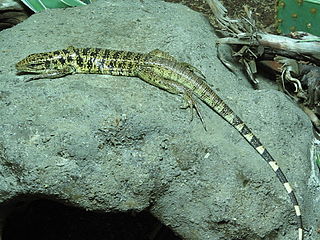
Teiidae is a family of Lacertoidean lizards native to the Americas. Members of this family are generally known as whiptails or racerunners; however, tegus also belong to this family. Teiidae is sister to the Gymnopthalmidae, and both families comprise the Teiioidea. The Teiidae includes several parthenogenic species – a mode of clonal reproduction. Presently, the Teiidae consists of approximately 150 species in eighteen genera.

A grison is any mustelid in the genus Galictis. Native to Central and South America, the genus contains two extant species: the greater grison, which is found widely in South America, through Central America to southern Mexico; and the lesser grison, which is restricted to the southern half of South America.
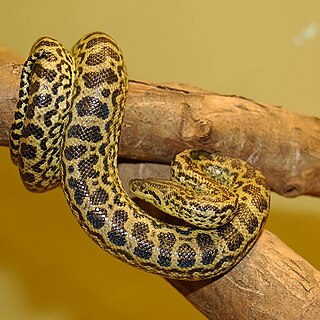
The yellow anaconda, also known as the Paraguayan anaconda, is a boa species endemic to southern South America. It is one of the largest snakes in the world but smaller than its close relative, the green anaconda. No subspecies are currently recognized. Like all boas and pythons, it is non-venomous and kills its prey by constriction.
The Saint Croix racer is a possibly extinct species of snake in the family Colubridae that is endemic to the island of Saint Croix in the United States Virgin Islands.
Agkistrodon howardgloydi is a species of venomous snake, a pit viper in the subfamily Crotalinae of the family Viperidae. The species is endemic to Central America. It is most commonly called castellana, but it has also been called the southern cantil, Gloyd's moccasin, and a number of other colloquial names. It is a rare species with a relatively small geographic distribution in the tropical dry forest on the Pacific coast of Honduras, Nicaragua, and extreme northwest Costa Rica. A. howardgloydi is a stout, medium-sized snake with a maximum total length of 96 cm (38 in). It is a viviparous species, with females giving birth in the rainy season from May to August. No clinical reports on envenomation had been published, but laboratory texts and analysis indicate the venom is highly toxic and similar to its close relative Agkistrodon bilineatus, and potentially lethal.
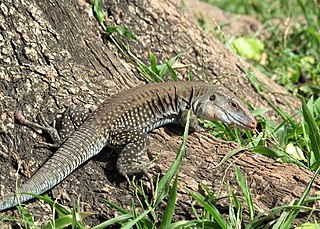
The common Puerto Rican ameiva or Puerto Rican ground lizard is a species of lizard in the whiptail family.

Holcosus festivus, commonly known as the Central American whiptail, the Middle American ameiva, and the tiger ameiva, is a species of lizard in the family Teiidae. The species is native to Central America and northern South America.

Holcosus quadrilineatus, also known commonly as the four-lined ameiva and the four-lined whiptail, is a species of lizard in the family Teiidae. The species is endemic to Central America.
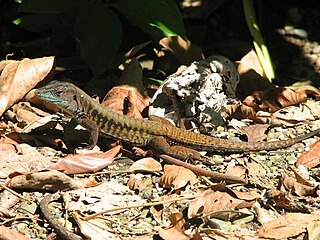
Holcosus leptophrys, also known commonly as the delicate ameiva and the delicate whiptail, is a species of lizard in the family Teiidae. The species is native to Central America and northwestern South America.

Holcosus undulatus, also known commonly as the barred whiptail, the metallic ameiva, and the rainbow ameiva, is a species of lizard in the family Teiidae. The species is endemic to Mexico. There are three recognized subspecies.
A number of species of lizard are named rainbow ameiva, including:
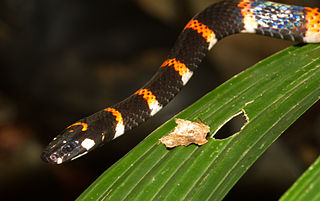
Pliocercus euryzonus, commonly known as Cope's false coral snake, is a species of snake in the subfamily Dipsadinae of the family Colubridae. The species is indigenous to southeastern Central America and northwestern South America. There are two recognized subspecies.

Ialtris is a genus of snakes in the subfamily Dipsadinae of the family Colubridae. The genus is endemic to the island of Hispaniola.

Holcosus anomalus, also known commonly as Echternacht's ameiva, is a species of lizard in the family Teiidae. The species is endemic to Colombia.

Holcosus bridgesii, also known commonly as Bridges's ameiva , is a species of lizard in the family Teiidae. The species is native to northwestern South America.

Holcosus chaitzami, also known commonly as Chaitzam's ameiva, is a species of lizard in the family Teiidae. The species is native to extreme southern North America and Central America.
Holcosus orcesi, also known commonly as Peters' ameiva, is a species of lizard in the family Teiidae. The species is endemic to Ecuador.

Holcosus septemlineatus, also known commonly as the seven-lined ameiva or the lagartija terrestre de cola azul (Spanish), is a species of lizard in the family Teiidae. The species is native to northwestern South America.

Chilabothrus strigilatus, also known commonly as the Bahamian boa, is a species of snake in the family Boidae. The species is endemic to the Bahamas. There are five recognized subspecies.


















